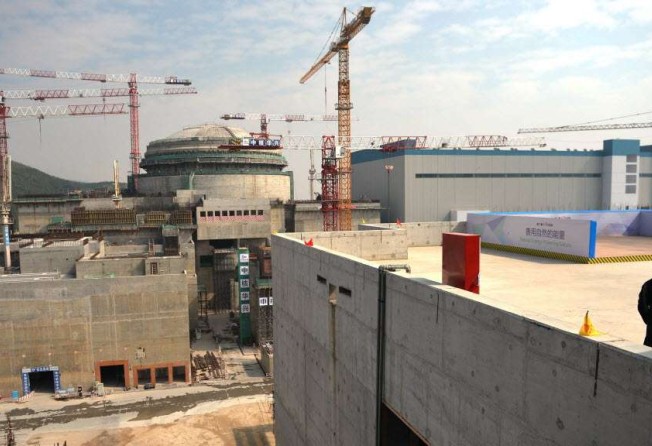
Hong Kong experts flag fresh concern over Guangdong nuclear plant after serious flaws found in similar French facility
Green groups ask for answers on potential problems at Taishan nuclear power station being built 130km from the city

Fresh questions are being asked about whether a Guangdong nuclear power plant being built just 130km west of Hong Kong could have the same serious structural flaws found in tests at a similar reactor in Normandy in northern France.
Green groups and planning experts say cities across the region should consult each other on the potential environmental impacts of nuclear projects, including that at Taishan.
Previous anomalies identified in the steel structure of the Flamanville 3 reactor’s lid and bottom included substandard mechanical resistance and excess carbon concentration in the metal, making it prone to small cracks which can spread.
But France’s Nuclear Safety Authority (ASN) was told last week that new material and sampling tests showed carbon segregation had extended “beyond mid-thickness” in the steel. French manufacturers Areva and EDF said they would extend tests deeper into the steel and have results ready by the end of the year.
Work at Flamanville’s 1,650MW European pressurised reactor, or EPR, began in 2007. Work was scheduled for completion in 2012, but it has been delayed until 2018 at triple its original cost.
It is not known how Taishan’s operator, state-owned China Guangdong Nuclear Power (CGN), will take into account the findings. The plant’s first two 1,750MW Areva-manufactured EPRs are expected to commence operation as early as next year even though the French test report has yet to be completed.
CGN did not respond to Post inquiries. It emerged last year that Taishan did not undergo the same quality tests as the ones at Flamanville. The reactor vessels at Flamanville were manfuactured by Areva's Le Creusot Forge plant, which also supplied reactor vessels to CGN for Taishan.
Hong Kong’s Security Bureau acknowledged the latest tests and said it understood China’s Nuclear Safety Administration was already following up on the issue.
"The construction and operation of nuclear power stations in the mainland are regulated by relevant national regulations for civilian nuclear facilities, and have to comply with national regulatory requirements before the plants can be awarded construction and operation licences," a spokesman said.
Greenpeace Germany senior nuclear specialist Shaun Burnie said the carbon problem posed a much more serious risk than previously thought.
He said the main concern was “thermal shock” to steel riddled with brittle fractures. As hot nuclear fuel burns inside the reactor vessel, heat comes outwards through the steel. But cold water must be injected from the outside if the reactor needs cooling in an emergency.
“If the carbon problem affects the outer 50 per cent of the vessel head steel, you will have to assess it from a cold-to-hot ratio. But because the carbon problem is found to go beyond 50 per cent, they also have to consider hot-to-cold, which is a far more serious risk for the reactor vessel’s structural integrity,” Burnie said.
“If the tearing goes from the centre into the reactor core itself, where you have all the radioactive material, it is a far more serious consequence.”
Burnie predicted three likely outcomes for the plant in Normandy: working at a lower operating capacity for its entire lifespan, changing the top and bottom vessel heads or scrapping the project.
“The French state may well decide to operate it at reduced power because it is less costly than to replace parts,” he said. Replacing EPR vessel tops and bottoms was expensive and never done before, and doing so at Flamanville would also mean replacing those at Taishan, he said.

Greenpeace East Asia senior campaigner Frances Yeung Hoi-shan urged the Hong Kong government to seek answers about the latest safety situation at Taishan. “It is irresponsible of them to say everything is okay,” she said.
The group brought up the UN Espoo Convention, which sets out the obligations of signatory states to assess the environmental impact of certain activities and notify and consult each other on all major projects that are likely to have a significant adverse environmental impact across borders. China is not a signatory.
Chinese University geography professor Ng Mee-kam said Taishan was just one of many new nuclear plants being built in Guangdong, and it was time to consider better regional planning and cooperation.
The Security Bureau said Taishan was too far from Hong Kong to pose any threat from an off-site radioactive release caused by a nuclear accident. It added that international standards set 15 to 30km as the maximum radius for taking urgent protective action.
"Even in the rare event of an off-site radioactive release caused by a serious nuclear accident at Taishan, the possibility of having to take full-scale countermeasures against the impact of radioactive plume on Hong Kong would be extremely low, as radioactive materials will be continuously diluted as they disperse from the nuclear power station," the bureau spokesman said.